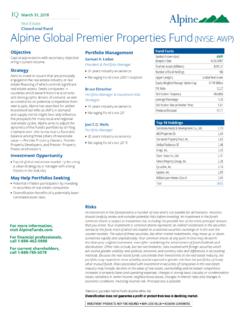Transcription of October 31, 2017 - Alpine Funds
1 Annual Report2017 October 31,Global Premier Properties FundAlpine Global Premier Properties Fund (the Fund ), acting in accordance with an exemptive order received from the Securities and ExchangeCommission (the SEC ) and with approval of its Board of Trustees (the Board ), has adopted a level distribution policy (the Policy ) with thepurpose of distributing over the course of each year, through periodic distributions as nearly equal as practicable and any required special distri-butions, an amount closely approximating the total taxable income of the Fund during such year and all of the returns of capital paid by portfoliocompanies to the Fund during such year. In accordance with its Policy, the Fund distributes a fixed amount per common share, currently $ ,each month to its common shareholders.
2 This amount is subject to change from time to time in the discretion of the Board. Although the level ofdistributions is independent of Fund performance, the Fund expects such distributions to correlate with its performance over time. However,there is no assurance that the Fund will be able to do so. Each monthly distribution to shareholders is expected to be at the fixed amount estab-lished by the Board, except for extraordinary distributions and potential increases or decreases in the final dividend periods for each year in lightof the Fund s performance for the entire calendar year and to enable the Fund to comply with the distribution requirements imposed by the In-ternal Revenue Code of 1986, as amended. Over time, the Fund expects that the distribution rate in relation to the Fund s net asset value( NAV ) will approximately equal the Fund s total return in relation to the Fund s fixed amount of distributions will be reviewed by the Board at regular intervals with consideration of the level of investment income and realized gains.
3 The Board strives to establish a level regular distribution that will meet the Fund s requirement to pay out all taxable income (including amounts representing return of capital paid by portfolio companies) with a minimum of special distributions. The Fund s total returnin relation to changes in NAV is presented in the financial highlights table. Shareholders should not draw any conclusions about the Fund s investment performance from the amount of the current distribution or from the terms of the Fund s level distribution policy. The Board mayamend or terminate the level distribution policy without prior notice to Fund should note that the Fund s Policy is subject to change or termination as a result of many factors. The Fund is subject to risksthrough ownership of its portfolio company holdings including, but not limited to, declines in the value of real estate held by the portfolio company, risks related to general and local economic conditions, and portfolio company losses.
4 Moreover, an economic downturn could have amaterial adverse effect on the real estate markets and on real estate companies in which the Fund invests, which in turn could result in the Fundnot achieving its investment or distribution objectives thereby jeopardizing the continuance of the Policy. Please refer to the prospectus for afuller description of the Fund s 12/22/17 8:20 PM Page IFC1 Alpine View 1 Manager Commentary 4 schedule of Portfolio Investments 13 Statement of Assets and Liabilities 16 Statement of Operations 17 Statements of Changes in Net Assets 18 Financial Highlights 19 Notes to Financial Statements 20 Report of Independent Registered Public Accounting Firm 27 Additional Information
5 28 TABLE 12/22/17 8:20 PM Page toc1[THIS PAGE INTENTIONALLY LEFT BLANK] 12/22/17 8:20 PM Page toc2 Alpine ViewOctober 31, 2017 TAX CUTSAn element of uncertainty has been introduced by the RepublicanCongress which is planning to put forth an economic stimulativeprogram, packaged as tax reform. This has been cooked up in oldschool style, in back rooms with no transparency, nor based onspecific intellectual precepts or schools of thought, this grab bagrestructuring of the tax code is in some ways progressive, in otherways regressive, both positive and negative, and which will no doubtbe beneficial to some and negative for others in our economy. On thesurface, it is positive for corporations, many of whom should seelower tax rates and it is intended to stimulate capital investment inthe short-term through accelerated depreciation of new investments(as low as one year down from five to twenty!)
6 , which offsets which repatriate capital from overseas will have very low(6-12%) recapture rates if they bring money home (estimates that $1-2 trillion may come back over several years). However, investment inresearch and development (R&D) for better future products do notreceive such benefit. This should be positive for stocks in that it willno doubt lead to more corporate buy-backs and special dividends forshareholders, and we may well see a short-term investment boomover the next 12-18 months. Such a jumpstart would have been usefulback in 2009 or 2010 but may create a boom/bust surge in activitywhich could induce the Fed to rapidly defend against inflation. Ofcourse, we do not know what percentage of the trillions held abroadheld by companies such as Apple and Microsoft, among others, willbe repatriated nor, the final details of the tax rates.
7 So, we await andhope it will be more rational than feared. Nevertheless, thesignificance will likely be a short-term stimulus effect, with potentialnegative implications for the long-term when the payback for thesetax cuts could come in the form of deficits which need to be said capital markets may take a long-term perspective, pushinginterest rates higher to reflect this. Fundamentally, just as the (and global) economy is getting stronger, we believe it would be betterto stimulate future growth by targeting better infrastructure andeducation and R&D for promising technologies and products, ratherthan to get a quick boost followed by rapidly rising interest RATESThe Fed has made it clear that they are looking forward to raisinginterest rates in December 2017 and then again up to four times in2018.
8 We believe that it may only be two or three increases after theFed Funds Rate rises from today to above in December,probably to by early Summer 2018, and at least by year-end 2018. It should be noted that the Fed s dot plot has rates risingto over 2% by year end 2018 and over by year end 2019. Muchdepends on the impact of the aforementioned new tax plan and therate at which other central banks begin to withdraw from quantitativeeasing. Our concern is that the current Goldilocks environment ofvery low interest rates and moderate economic activity, which hasbeen so beneficial for the stock market, may be upset if interest ratesrise more quickly than the Fed has guided and if Funds retreat fromthe capital Shareholders:During the fiscal year ended October 31, 2017 , the equity marketsfinally side-stepped their broad apprehension, which has been acharacteristic of market sentiment since the great financial collapseof 2008.
9 As we pointed out in prior reports to shareholders, themarket was greatly concerned about either the risks of imminentinflation due to the stimulative effects of loose monetary policy, oralternatively, a deflation drag due to over-capacity and structuralimbalances remaining from prior expansions. Following the Reserve s (Fed) warning of an imminent transition fromquantitative easing (QE) towards normalization back in May of 2013,the capital markets suffered from a taper tantrum before assumingan alternating risk-on/risk-off mode that persisted well into , in the fourth quarter of 2015, a speculative commodityboom that had become a bust lasting into February of 2016, re-engaged persistent fears of global economic deflation. As it turnedout, the economy found its footing and markets recovered through2016, and ultimately produced double-digit returns this year, asinvestors have bought equities to capture corporate growth.
10 Strongeconomic reports have become more consistent and corporateearnings and revenue growth appears more sustainable as weapproach equity markets focus this year has been particularly strong forgrowth stocks, as opposed to value stocks or stocks of stabledefensive companies. In particular, the market has been focused ontop-line revenue growth and companies with strong , the market has also favored companies with relativelylow financial leverage and, thus, a greater margin of safety. Stockswhich combined these characteristics performed particularly , we appear to be in the midst of a synchronized globaleconomic recovery in which Gross Domestic Product (GDP) has beensupported by strong orders for goods and services, witness regionaland national purchasing managers indices (PMI) and improvingemployment data.






